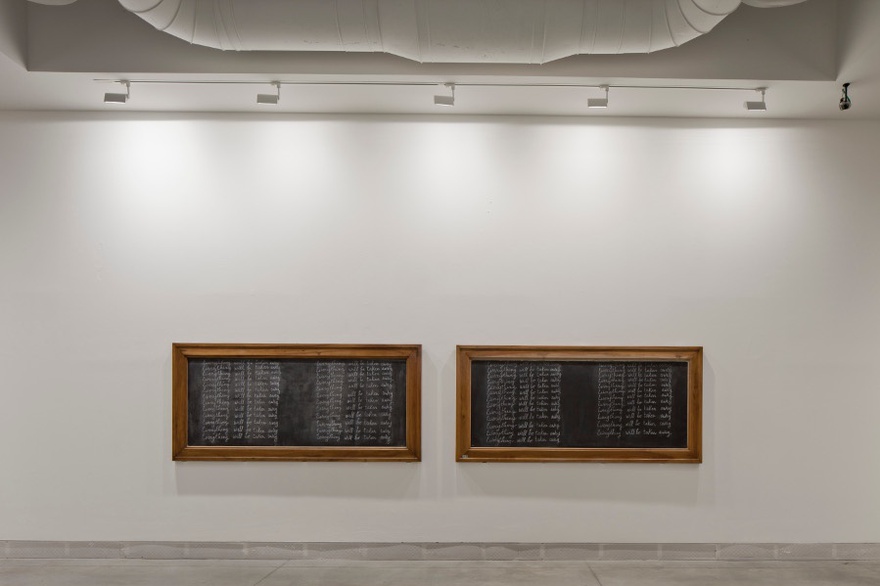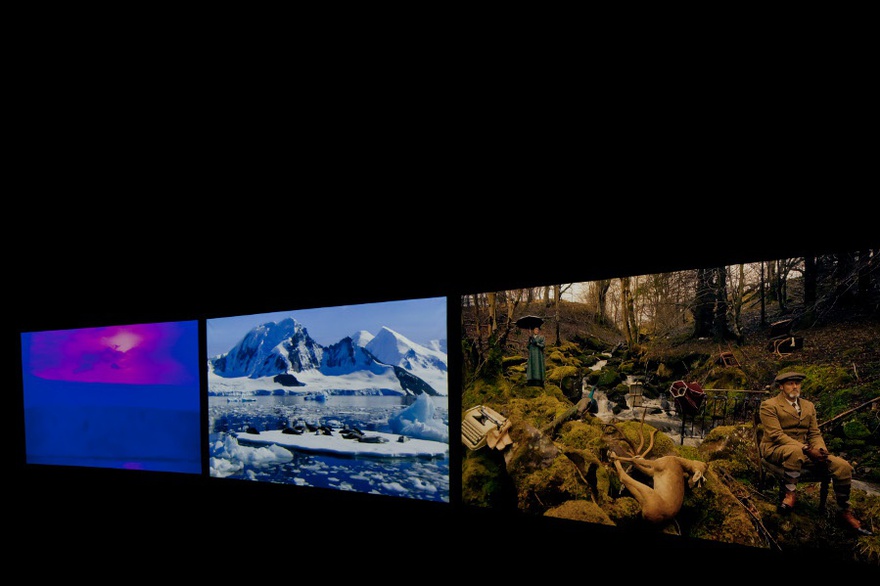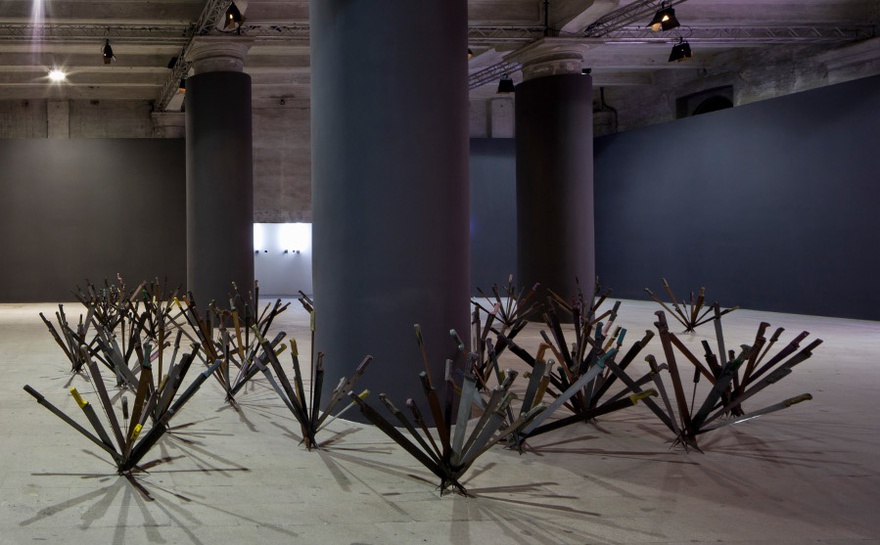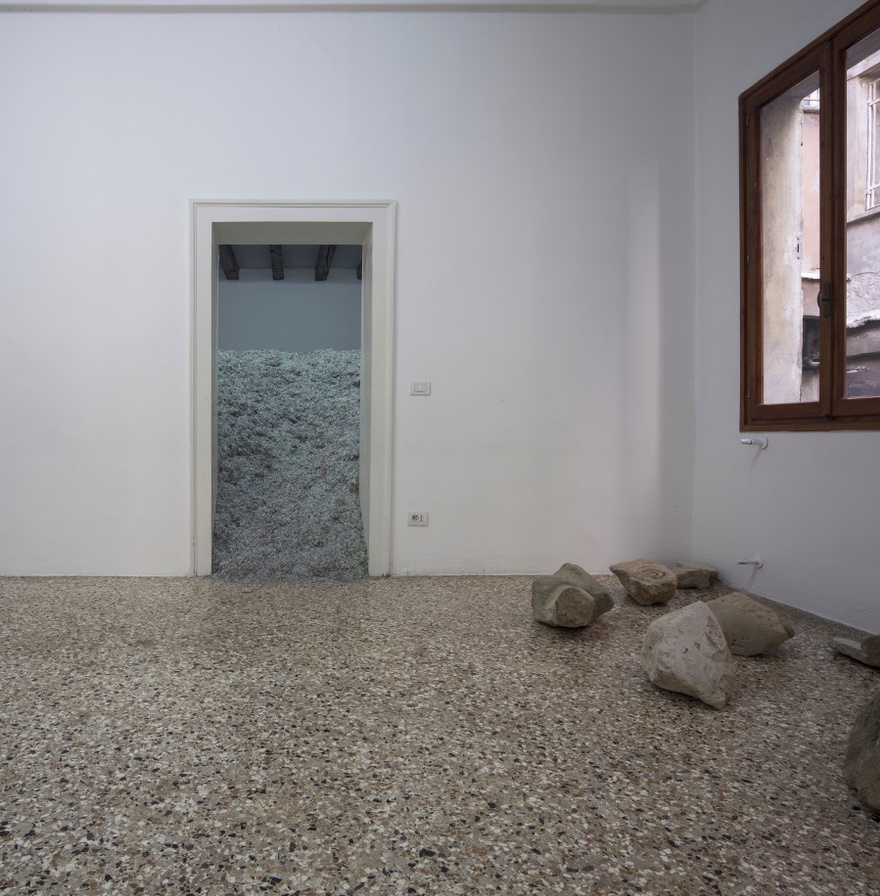Reviews
All the World’s Futures
A Review of the 56th Venice Biennale
In the ever more convoluted market for financial derivatives, a 'future' is an agreement between a buyer and a seller that attempts to protect high-risk ventures (such as crops subject to unpredictable harvests) by fixing the price of an exchange in advance. Intended to mitigate risk, the futures market effectively paves the way for speculation and hedging by allowing traders to play against terms set in the past. It stands to reason that one cannot impose a present certainty onto a future unknown without some cost.
Curator Okwui Enwezor has built his career using an inverse technique, scanning the present for signs of a still unsettled past. Alongside the announcement of the theme of his highly-anticipated exhibition for the 56th Venice Biennale – All the World's Futures – came the tantalizing possibility that we might finally glimpse the curator's vision of what's to come. But when the biennale opened this May – a month earlier in concession to the World's Fair in Milan (another exercise in futurological spectacles) – audiences were greeted with a tight-lipped survey whose imagination of the future was firmly rooted in the recent history.
This is not the first time Enwezor has proposed a reading of the future through a prism of the past. One of his favourite curatorial conceits is to invoke Walter Benjamin's description of Paul Klee's Angel of History, a creature that moves towards the future with its back turned, its face fixed resolutely on the past. The motif crystallizes in the much advertised, but barely-resonant live readings of Karl Marx's Das Kapital, carried on intermittently throughout the course of the exhibition. In a more immediate gesture, however, Enwezor has given the Giardini's Central Pavilion an angel of its own, in the form of Fabio Mauri's Macchina per fissare acquerelli (2009), a stepladder stretching its neck to the very top of the Galileo Chini-painted cupola at the very entrance to the exhibition. Its very last step bears the simple message, 'The End'. Another recurring motif comes courtesy of Adrian Piper – the recipient of this year's Golden Lion – who periodically punctuated the exhibition with a series of partially erased photographs and chalkboards scrawled with the words 'Everything will be taken away.' Piper's vision of the future is thus one of deficit, forgoing the fantasizing inspired by glossy promises of technology and leisure time to emphasize what will be lost, over what might be gained. The result is an exhibition predicated on All the World's Futures that fails to fully articulate any of the world's futures, since futures are written exclusively using the terms of its past.
As for the present: all its civil wars, political uprisings and protests filter into the exhibition's penchant for violence. Taking the site at its name, Enwezor strings a daisy chain of decorative armaments across the Arsenale, from Adel Abdessemed's knife bouquets to Monica Bonvicini's rubber-coated chainsaw chandeliers. A gauntlet of Lynch Fragments (1963–ongoing), Melvin Edward's welded-steel wall hangings, followed by Abu Bakarr Mansaray's densely packed sketches for imaginary weapons, leads up to Pino Pascali's homemade Cannone Semovente (1965). As part of their A Universe of Collisions, The Propeller Group presents The AK 47 vs The M16 (2015), gel-encased trajectories of bullets from each of the titular weapons, fired so that the bullets might collide, fusing into one projectile. In some of the rare instances of ceasefire, Gonçalo Mabunda fashions thrones from discarded casings and old pistols, while Hiwa K uses the metal from abandoned weapons and war machines to cast a bell, an act of reparation for a history of bells melted down for munitions in times of war.
The victims of all this violence are suggested by a conscious insertion of black bodies, whether in the paintings of Kerry James Marshall, Lorna Simpson or Lavar Munroe, in Steve McQueen's blistering requiem Ashes (2014–2015), or through Lili Reynaud Dewar's conflicted My Epidemic (Small Bad Blood Opera) (2015), which inserts the artist's appropriation of Josephine Baker's signature moves into an 'opera' confronting social mores, personal responsibility and sexual practices in the age of HIV. The façade of the Giardini Central Pavilion is crowned with a neon from Glenn Ligon reading 'blues blood bruise' over a series of body-bag-like black canvases churlishly titled signalling devices now in bastard territory (2015), originating from the studio of Oscar Murillo. Formally, these pair with Ibrahim Mahama's Out of Bounds (2015), a tapestry of jute sacks – presented as both witness and relic of global production and distribution – lining the long alley leading out of the Arsenale.
But the real weapons in this exhibition are often tucked out of easy reach, with fearless films by Naeem Mohaiemen, Coco Fusco and the Syrian collective Abounaddara consigned to dark corners or the Arsenale's infamously-overlooked back garden. Some works demand this insulation. For instance, Im Heung-Soon's Factory Complex (2014), in which female factory workers recount atrocities, disfigurations and even diseases brought on by exposure to chemicals at a Samsung Factory, contaminates the surrounding space of its black box in the Arsenale. It makes it impossible to look at the neighbouring work by Kutluğ Ataman, The Portrait of Sakip Sabanci (2014) – a flying carpet of nearly a thousand miniature LED screens shuffling through faces of the deceased tycoon and philanthropist's acquaintances – without tallying the unseen victims behind each device. Likewise, one of the biennale's true showstoppers – John Akomfrah's three-channel stunner, Vertigo Sea (2015), which mobilizes nearly forty minutes of HD footage of nature at its most screensaver-esque (cue the churning seas and spiralling starling murmurations) spliced with brutally blunt images of whaling to create a morality play on humanity's interaction with its environment – gained an additional, gut-wrenching relevance during the biennale's opening week, as thousands of refugees were reported to have drowned in attempts to cross the Mediterranean.
In an instance of more direct engagement as part of the live programming within a specially designed Arena, Abounaddara provided weekly broadcasts on the situation in Syria (timed to coincide with the Friday protests). These updates were supplemented with a compendium of past video clips, titled Syria: Snapshots of History in the Making (2014). In one segment, a boy almost boastfully tells the camera crew about how his neighbour, upon having his hand blown off, stooped to pick up the lost appendage before continuing to flee. The casualness of the child's tone cuts more deeply than all the other weaponry, effectively calling the bluff in the exhibition's presentation of violence. He is testament to Piper's promise made good, with everything taken away not in some far-away future, but in an all too real present.
Outside Enwezor's main exhibitions, several national pavilions took the curator's cue in turning their eyes – however symbolically – towards historical wounds. Australia countered the fresh-out-of-the-package feel of its newly-svelte pavilion with the Wunderkammer run amok that was Fiona Hall's Wrong Way Time (2015), whose sardonically pseudo-ethnological undertones the Australian cultural delegation chose to fete with an appearance by Cate Blanchett and a 'traditional' smoke ceremony (perhaps poor party planning for a country currently so insistent on limiting the definitions of its citizenry). Belgium made a more believable effort to expand beyond the confines of Eurocentrism, rounding out the central film by Vincent Meessen with contributions from the likes of Mathieu K. Abonnenc, Maryam Jafri and Adam Pendleton. Poland also sought to reconcile with its colonial ties. Halka/Haiti 18°48'05″N 72°23'01″W (2015) saw artists C.T. Jasper and Joanna Malinowska staging a Polish opera in a Haitian village, as a nod to the nearly forgotten Polish-Haitian connection forged at the turn of the nineteenth century, when Polish soldiers sent to put down a slave rebellion ended up siding with the Haitians. Well-meaning intentions aside, however, the work insinuated the fact that there was something intrinsically different between people who might indeed share some of the same genetic material. As the camera tracks the faces of the village children, their expressions cycle through wonder, curiosity and eventually disinterest at this imported spectacle.
The theme of shared heritage took pride of place at the Armenian Pavilion, the winner of this year's Golden Lion. The ambitious Armenity marked the anniversary of the 1915 genocide by gathering artists of the diaspora in the Mekhitarist monastery of San Lazzaro, one of the critical safehouses of Armenian culture abroad. The contemporary work was threaded through the monastery's astounding collection of books, relics, artefacts and even mummies, which all sought to preserve the idea of 'Armenia'. Nina Katchadourian's three-screened video Accent Elimination (2005) offered lessons in a small reliquary, Anna Boghiguian's Birds (2013) patrolled the courtyard and Haig Aivazian's Hastayım Yaşıyorum (I am sick, but I am alive) (2014) – a wooden sculpture of near mouth-watering beauty, crafted using traditional methods for making an oud, a near-ubiquitous musical instrument in the Middle East – slid serenely into the library. Hallways were dotted with works by Sarkis, who simultaneously represented Turkey in the Arsenale. There his meditative Respiro (2015) paired lightboxes, neon rainbows and mirrored partitions artfully smudged with fingerprints, though arguably it was the notion that, on the anniversary of a much-contended genocide, Turkey and Armenia might share the same artist that left the most indelible impression.
For another of the Bienniale's more controversial pavilions, Christoph Büchel used his commission for Iceland to erect Venice's first functioning mosque, in an abandoned church in Cannaregio. While the artist did reach out to the Muslim community of Venice, he failed to do due diligence with the municipal authorities; predictably the mosque was quickly closed, a decision which, just as predictably, led to inflammatory rhetoric on both sides of the debate. Controversy also surrounded the Syrian Pavilion, which touched on the country's current situation with a series of works mourning the plight of its refugees – a statement that was mediated (and more precisely, paid for) by an additional room, bursting with dismally cheerful paintings by a mix of Chinese and Italian artists. If Belgium and Armenia broke geographic borders as a way to mobilize the definition of nationality, the Syrian Pavilion seemed more motivated by financial concerns. Indeed, as the drive towards spectacle accelerates at near untenable speeds, this model of spiking one's pavilion with commercial work from other nations is fast becoming one of the biennale's most popular funding methods – though not without cost. Kenya disowned their pavilion just days before the opening, after rejecting its Italian curator's justification for the overwhelming presence of Chinese artists as an opportunity for Kenyan artists 'to meet the rest of the world'.
If these mercenary tactics raised fears for all the biennale's futures, one pavilion did present a sound model of sustainability and elegance: Christodoulos Panayiotou's Cyprus Pavilion, Two Days After Forever. Framed as a critique of traditional archaeology, Panayiotou's objects do not belong to any one particular moment, containing within themselves entire life cycles. One series of wall-mounted mosaics were pieced together from ancient tesserae, on loan from the Archaeological Museum in Nicosia. After the exhibition closes, the mosaics will be dismantled, their parts returned to the museum to be reassembled into their original compositions. In this way, the artist taps into the transformative powers of art without propagating the production of unnecessary objects. In other words, he is quite literally recycling the matter of the past in a manner that takes stock of the future without condemning it. By effectively teaching the Angel of History how to pirouette, Panayiotou looks beyond 'all the world's futures' to offer some of the most forward-thinking work in Venice.









